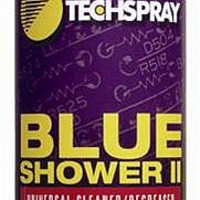1667-8S Techspray, 1667-8S Datasheet - Page 6

1667-8S
Manufacturer Part Number
1667-8S
Description
Chemicals Blue Shower II, 8 oz aerosol
Manufacturer
Techspray
Type
Degreaserr
Datasheet
1.1667-18S.pdf
(7 pages)
Specifications of 1667-8S
Product
Cleaners & Degreasers
Size
8 oz
Container
Aerosol
Application
Precision cleaning of polar and nonpolar soils, including hand oils, solder oils, greases, silicone, fluxes, and similar soils. Excellent for tape head cleaning and general degreasing.
Boiling Point
58 °C
Chemical Component
1, 3-Dichloro-1, 1, 2, 2, 3-Pentafluoropropane/3, 3-Dichloro-1, 1, 1, 2, 2-Pentafluoropropane/Aerosol-1, 1, 1, 2-Tetrafluoroethane/Carbon Dioxide (Aerosol Propellant)/Ethanol/Methanol/Nitromethane
Dispensing Method
Aerosol
Evaporation
1 (Min.)
Primary Type
Cleaner
Special Features
Non-Flammable
Weight
8 Oz.
Lead Free Status / RoHS Status
Lead free / RoHS Compliant
10. STABILITY AND REACTIVITY
11. TOXICOLOGICAL INFORMATION
Blue Shower II
SOLUBILITY IN WATER: Insoluble
EVAPORATION RATE: >1 (n-Butyl Acetate=1)
(VOC): 125 to 135 g/L (non-exempt VOC)
CONDITIONS TO AVOID: Stable. However, may decompose if heated.
STABILITY: Stable.
POLYMERIZATION: Will not occur.
HAZARDOUS DECOMPOSITION PRODUCTS: May form hydrochloric and hydrofluoric acids - possibly
carbonyl halides, when exposed to high temperatures.
INCOMPATIBLE MATERIALS: Oxidizing agents, alkalies and bases.
ACUTE
TERATOGENIC EFFECTS: Test results indicate this compound/mixture is not teratogenic.
GENERAL COMMENTS: Data from acute toxicity studies indicate that HCFC-225ca and HCFC-225cb have
very low acute toxicity. Neither isomer causes eye irritation nor dermal toxicity in standardized tests; skin
application of both isomers at high doses (2,000 mg/kg body weight) produces no adverse effects. Therefore, the
dermal LD50s are greater than 2,000 mg/kg body weight. Oral administration of either isomer at high doses (5,000
mg/kg body weight) does not cause any mortality and the oral LD50s are greater than 5,000 mg/kg body weight.
Both isomers also have very low acute inhalation toxicity as measured by the concentration that cause 50%
mortality in experimental animals.
In 28-day inhalation studies with rat, the activity and responsiveness of the animals was reduced at 5,000 ppm or
greater for each isomer. Toxicity was otherwise confined to the liver; liver enlargement and induction of
peroxisomes was seen following treatment with either of the isomers. HCFC-225ca was more potent than HCFC-
225cb in eliciting these lever effects. In a 90-day study of HCFC-225ca/HCFC-225cb mixture (45/55%) with rat,
toxic effects were observed in the liver; liver enlargement and induction of peroxisomes. In a 28-day study with
marmoset, exposure to HCFC-225ca at 1,000 ppm caused effects on the liver, such as slight fat deposition
associated with changes in serum biochemical parameters. In the same study, exposure to HCFC-225cb at 5,000
ppm caused somnolence during exposure and an increase of cytochrome P-450, indicative of an adaptive response
to HCFC-225cb. However, no liver enlargement was seen and virtually no peroxisome induction was observed in
either isomer.
EYES: Moderately to severely irritating
DERMAL LD
ORAL LD
INHALATION LC
50
: Slight to very low toxicity.
50
: Mildly to moderately irritating.
50
: Slight to very low toxicity.






